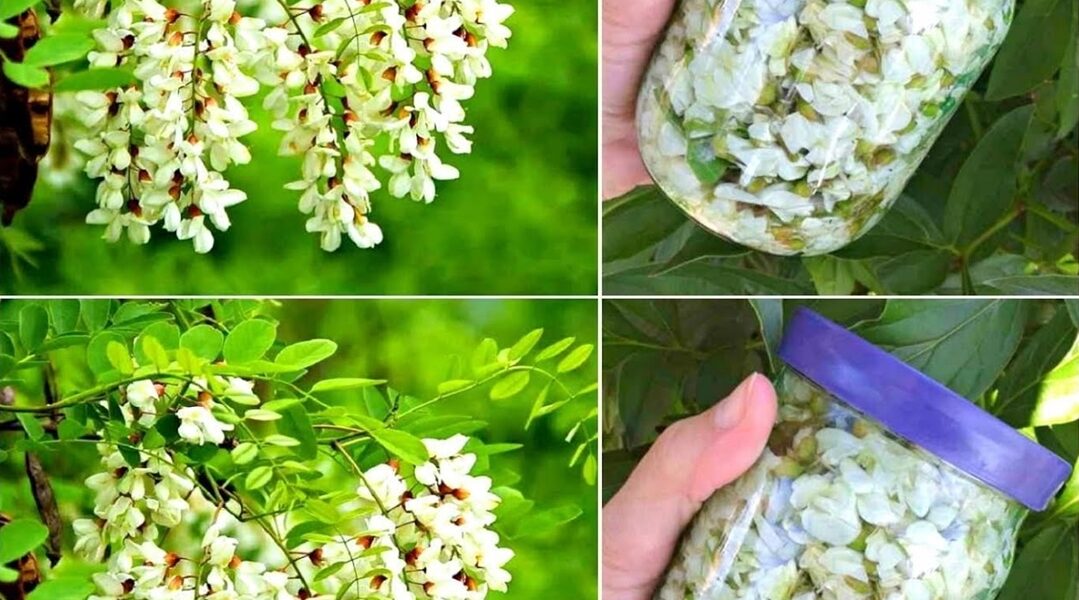Tincture of white acacia cures numbness of limbs headache cystitis etc.
The white acacia is a large tree, the height of which reaches 15-20 meters.
This tree belongs to the legume family and is very often used in the folk treatment of various diseases.
The white acacia has a beautiful and spreading crown, longitudinal cracks are visible on the trunk of the tree. The trunk of the white acacia is gray-black or gray-brown in color.
The shoots and young branches of the acacia are green and smooth.
The leaves of the acacia are ovate and arranged oppositely on stalks of 7-21 pieces.
The outside of the leaves is smooth and green, and the inside is velvety gray-green. The white flowers of the acacia are white, have a pleasant smell and are collected in brushes that hang down.
The white acacia blooms from the end of May and ripens in June. The fruit of the white acacia is a dark brown flat pod with 4–6 grain-like seeds.
The white acacia was first noticed in North America, and then it was brought to the southern part of our country.
This tree grows most often in parks, gardens and roadsides.
Collection and storage of white acacia
The medicinal raw materials are the flowers, fruits, leaves and bark of the white acacia.
The flowers should be picked at their flowering stage and collected in a semi-inflated form.
Drying should be done in a room that is well ventilated and has a temperature of 40-50°C.
Bark and leaves should be collected during the growing season.
Medicinal properties and application of white acacia
In folk medicine, a decoction of white acacia bark is used, it helps people who have acute gastritis or peptic ulcer.
Young shoots and leaves are raw material for the preparation of tincture, which is taken during an exacerbation of peptic ulcer and gastritis.
Decoction and decoction of white acacia flowers are used for diseases of the kidneys, bladder, and also for rheumatism.
The flowers are used by combining with the leaves of the common bearberry, the flowers of the common tansy, as well as the flowers of blue cornflower and licorice root.
The chemical composition of white acacia
The chemical composition of white acacia and especially its fruits is not yet fully understood. Acacia bark and flowers contain the flavonoid robinin.
This substance has a hypoazotemic effect – it removes urea from the body. Medicines are made on the basis of Robinin.
However, this substance is toxic, which means that self-treatment of any disease with the help of acacia is dangerous, in any case you should consult a doctor.
The flowers and leaves contain various flavonoids, fatty oils, glycosides, essential oils, tannins, pectins and sugars, vitamins and minerals, as well as organic acids.
White Acacia Treatment Recipes
1. For fibroids of the uterus and inflammatory disease of the female genital organs, a decoction prepared from white acacia flowers is taken.
To prepare it, take 1 tablespoon of dried flowers and pour two cups of water, bring to a boil and leave for another 2 minutes on a low heat to boil a little.
Then strain the contents, cool and add water to get as much as it was before boiling.
Such a decoction should be taken daily 3-4 times half an hour before meals, 1 tbsp. spoon.
2. Tincture of white acacia flowers is taken for infertility. To do this, pour 10 grams of flowers (fresh) with 10 grams of alcohol or vodka.
All this stays for 10 days.
This tincture should be taken 3 times a day, but not in pure form, but diluted: 20 drops of tincture should be mixed with one tablespoon of water.
3. For rheumatism, myositis, numbness of the limbs, joint pain and sciatica, rubbing is done.
To do this, you need to take 2 glasses of vodka, pour 50 grams of acacia flowers into them, leave for three weeks in a dark room, but do not forget to shake from time to time.
When the mixture has stood enough, strain – and the rubbing liquid is ready. Rubbing should be done several times a day.
4. A decoction of white acacia leaves is used for coughs and colds or as a reduction in temperature.
You need to take a tablespoon of dried leaves, crushed into powder, add 1 cup of boiling water, put on the stove and cook for 5 minutes on low heat.
After that, the mixture should be cooled, strained and taken 3 times a day before meals, 1 tablespoon.
5. Acute and chronic cystitis can be cured by collecting white acacia flowers, wheatgrass root, calendula flowers.
50 grams of these herbs should be poured with 300 milliliters of water, brought to a boil, and boiled for 8 minutes.
After that, the mixture should be removed from the heat and stand for 60 minutes, after which it is filtered and more boiling water is added to the original volume. You should drink such a decoction 3 times a day before meals, 50 ml each.
Acacia honey
As a honey-bearing plant, from the white salcum bees produce the acacia honey we all know – with a light color and a pleasant aroma.
An extremely useful product that is used in digestive and respiratory diseases. It alleviates disease states and strengthens the body.
Contraindications for the use of white acacia
White acacia should be taken in moderate doses because a large dose is poisonous.
Acacia bark is the most dangerous because it contains robin toxalbumin, a toxic protein substance that can irritate mucous membranes.
The flowers of the plant are considered safe for consumption, but with a large intake of them, nausea, vomiting, headaches are observed.
The herb should not be used in the presence of inflamed kidneys.
If you like the article, you can follow us and share it with your friends:
Source: bilkolechenie.bg
